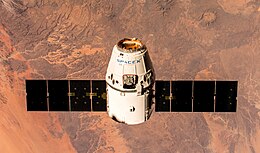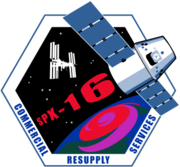2018 American resupply spaceflight to the ISS
"CRS-16" redirects here. For the Northrop Grumann CRS-16 mission, see
Cygnus NG-16 .
SpaceX CRS-16 CRS-16 Dragon approaching the ISS
Names SpX-16 Mission type ISS resupply Operator SpaceX COSPAR ID 2018-101A SATCAT no. 43827 Mission duration 39 days, 10 hours, 54 minutes
Spacecraft Dragon 1 C112 Spacecraft type Dragon 1 Manufacturer SpaceX Dry mass 4,200 kg (9,300 lb) Dimensions Height: 6.1 m (20 ft)
Launch date 5 December 2018, 18:16:00 UTC Rocket Falcon 9 Block 5 (B1050 )Launch site Cape Canaveral , SLC-40
Disposal Recovered Landing date 14 January 2019, 05:10 UTC [ 1] Landing site Pacific Ocean off Baja California
Reference system Geocentric orbit Regime Low Earth orbit Inclination 51.6°
Berthing port Harmony nadir RMS capture8 December 2018, 12:21 UTC [ 2] [ 3] Berthing date 8 December 2018, 15:36 UTC [ 4] Unberthing date 13 January 2019, 20:00 UTC [ 5] RMS release 13 January 2019, 23:33 UTC [ 6] Time berthed 36 days, 4 hours, 24 minutes
Mass 2,573 kg (5,672 lb) Pressurised 1,598 kg (3,523 lb) Unpressurised 975 kg (2,150 lb)
SpaceX CRS-16 , also known as SpX-16 , was a Commercial Resupply Service mission to the International Space Station launched on 5 December 2018 [ 7] Falcon 9 launch vehicle.[ 8] NASA and is flown by SpaceX .
This CRS mission was the first to be launched by the Falcon 9 Block 5 . It carried the Global Ecosystem Dynamics Investigation (GEDI) lidar and the Robotic Refueling Mission 3 (RRM3) experiment as external payloads.
Launch
In February 2016, it was announced that NASA had awarded a contract extension to SpaceX for five additional CRS missions (CRS-16 to CRS-20 ).[ 9] Inspector General report had this mission manifested in August 2018,[ 10] [ 11] [ 8] [ 12]
The first stage booster B1050.1 experienced a grid fin hydraulic pump stall on re-entry. This caused the first stage to go into a roll after the re-entry burn. It failed to reach Landing Zone 1 , but recovered enough to achieve a water landing off Cape Canaveral. Shortly after the landing, Elon Musk , CEO of SpaceX, stated the booster appeared undamaged and was being recovered. After recovering the booster, it was found to be too damaged to fly again and was scrapped for parts.[ 13]
On 13 January 2019, Dragon was released from ISS at 23:33 UTC and deorbited, splashing down in the Pacific Ocean approximately 5 hours later on 14 January 2019 at 05:10 UTC, returning more than 2,500 kg (5,500 lb) of cargo to Earth .[ 1]
Payload
NASA had contracted for the CRS-16 mission from SpaceX and therefore determined the primary payload, date/time of launch, and orbital parameters for the Dragon space capsule . CRS-16 carried a total of 2,573 kg (5,672 lb) of material into orbit. This included 1,598 kg (3,523 lb) of pressurised cargo with packaging bound for the International Space Station, and 975 kg (2,150 lb) of unpressurised cargo composed of two external station experiments: the Global Ecosystem Dynamics Investigation (GEDI) lidar and the Robotic Refueling Mission 3.[ 14] [ 15] Rodent Research-8 (RR-8).[ 12]
The CRS-16 mission also carried a pair of CubeSats originally planned to launch aboard the Cygnus NG-10 International Space Station (ISS) cargo resupply mission, but which were deferred. These included the UNITE CubeSat from the University of Southern Indiana and the TechEdSat-8 CubeSat from NASA's Ames Research Center .[ 16]
The following is a breakdown of cargo bound for the ISS:[ 17]
Crew supplies: 304 kg (670 lb)
Science investigations: 1,037 kg (2,286 lb)
Rodent Research-8 (RR-8) [ 18] Molecular Muscle Experiment (MME) [ 19]
Growth of Large, Perfect Protein Crystals for Neutron Crystallography (Perfect Crystals) [ 20]
Spacewalk equipment: 15 kg (33 lb)
Vehicle hardware: 191 kg (421 lb)
Computer resources: 40 kg (88 lb)
Russian hardware: 11 kg (24 lb)
External payloads:
Gallery
See also
References
^ a b Bergin, Chris (14 January 2019). "CRS-16 Dragon returns to Earth following ISS departure" . Spaceflight Now. Retrieved 21 January 2019 . ^ "Dragon in the Grips of Robotic Arm, Installation Occurs Next" . NASA. 8 December 2018. Retrieved 8 December 2018 .public domain .^ Gebhardt, Chris (8 December 2018). "Dragon brings the science; NASA, SpaceX realign DM-1 test to NET 17 January launch" . NASASpaceFlight.com. Retrieved 8 December 2018 . ^ Garcia, Mark. "Dragon Attached to Station, Returns to Earth in January" . NASA. Archived from the original on 14 December 2018. Retrieved 8 December 2018 . public domain .^ Richardson, Derek (13 January 2019). "CRS-16 unberthing, splashdown" . Orbital Velocity. Archived from the original on 19 April 2019. Retrieved 12 August 2020 . ^ Richardson, Derek (14 January 2019). "SpaceX Completes 16th Dragon Mission to ISS" . Spaceflight Insider. Retrieved 12 August 2020 . ^ Lewin, Sarah (5 December 2018). "SpaceX Launches Dragon Cargo Ship to Space Station, But Misses Rocket Landing" . Space.com. Retrieved 15 December 2018 . ^ a b Pietrobon, Steven (1 November 2018). "United States Commercial LV Launch Manifest" . Retrieved 1 November 2018 . ^ de Selding, Peter B. (24 February 2016). "SpaceX wins 5 new space station cargo missions in NASA contract estimated at $700 million" . SpaceNews. Retrieved 24 February 2016 . ^ NASA Office of Inspector General (28 June 2016). NASA's Response to SpaceX's June 2015 Launch Failure: Impacts on Commercial Resupply of the International Space Station (PDF) (Report). NASA Office of Inspector General. p. 13. Retrieved 18 July 2016 . public domain .^ "Launch Schedule" . Spaceflight Now. 31 May 2018. Archived from the original on 1 June 2018.^ a b Wall, Mike (4 December 2018). "Moldy Mouse Chow Delays SpaceX Dragon Launch to Space Station" . Space.com. ^ Thompson, Amy (20 December 2018). "A SpaceX Booster Went for a Swim and Came Back as Scrap Metal" . Wired. Retrieved 12 January 2021 . ^ Platnick, Steve (May–June 2018). "Editor's Corner" (PDF) . The Earth Observer . 30 (3). NASA/GSFC: 3. public domain .^ Richardson, Derek (5 March 2019). "ISS Astronauts Assemble Tools for Robotic Refueling Demo" . Spaceflight Insider. Retrieved 12 August 2020 . ^ Graham, William (5 December 2018). "Falcon 9 successfully lofts CRS-16 Dragon enroute to ISS – Booster spins out but soft lands in water" . NASASpaceFlight.com. Retrieved 6 December 2018 . ^ "SpaceX CRS-16 Mission Overview" (PDF) . NASA. Retrieved 20 April 2019 .public domain .^ "Rodent Research-8" . NASA/Space Station Research Explorer. Retrieved 12 August 2020 .public domain .^ Bartels, Meghan (28 September 2018). "Thousands of Worms Are Launching Into Space Soon. You Know... for Science" . Space.com. Retrieved 12 August 2020 . ^ Plain, Charlie (19 December 2018). "Crystal Clear: Finding Ways to Protect Crews from the Effects of Space Radiation" . NASA. Retrieved 12 August 2020 . public domain .^ Nevres, M. Özgür (2 May 2019). "GEDI: NASA's Laser Mission to Measure Trees" . Our Planet. Retrieved 12 August 2020 .
External links
Spacecraft Hardware Missions
Demo flights ISS logisticsCrewed missions
Ongoing spaceflights in underline Italics indicates future missionsSymbol † indicates failed missions
SpaceX missions and payloads
Launch vehicles Falcon 1 missions Falcon 9 missions
Demonstrations ISS logisticsCrewed Commercial
SES-8 Thaicom 6 Orbcomm OG2 × 6 AsiaSat 8 AsiaSat 6 ABS-3A / Eutelsat 115 West B TürkmenÄlem 52°E Orbcomm OG2 × 11 SES-9 JCSAT-14 Thaicom 8 ABS-2A / Eutelsat 117 West B JCSAT-16 AMOS-6 †Iridium NEXT 1–10EchoStar 23 SES-10 Inmarsat-5 F4 BulgariaSat-1 Iridium NEXT 11–20
Intelsat 35e Iridium NEXT 21–30
SES-11 Koreasat 5A Iridium NEXT 31–40
Hispasat 30W-6 Iridium NEXT 41–50
Bangabandhu-1 Iridium NEXT 51–55
SES-12 Telstar 19V Iridium NEXT 56–65
Telkom 4 (Merah Putih)Telstar 18V Es'hail 2 Iridium NEXT 66–75
Nusantara Satu / Beresheet Amos 17 JCSAT -18SXM 7Türksat 5A SXM 8
Türksat 5B Nilesat-301 SES-22 Galaxy 33 ,34
Hotbird 13F Hotbird 13G Galaxy 31,32 Eutelsat 10BOneWeb #15O3b mPOWER 1,2OneWeb #16
Amazonas Nexus OneWeb #17
SES 18,19
Intelsat 40e O3b mPOWER 3,4
Iridium NEXT 76-80 and OneWeb #19
ArabSat 7B SATRIA Galaxy 37 O3b mPOWER 5,6
Ovzon -3Merah Putih 2 Eutelsat 36D Galileo FOC FM25,27 WorldView Legion 1,2 Astra 1P Türksat 6A ASBM 1,2 WorldView Legion 3,4
BlueBird Block 1 Galileo FOC FM26,32
OneWeb #20
Koreasat 6AOptus-X /TD7GSAT-20 SXM 9
O3b mPOWER 7,8
Astranis Thuraya 4-NGS Scientific Military Starlink Rideshares
Falcon Heavy missions Starship missions
Flight tests Crewed Commercial
Ongoing spaceflights are underlinedFuture missions and vehicles under development in italicsFailed missions† are marked with dagger †
2000–2004 2005–2009 2010–2014 2015–2019 2020–2024 Future Spacecraft
Ongoing spaceflights in underline
Future spaceflights in italics
† - mission failed to reach ISS
January
USA-280 / Zuma BeiDou-3 M7 , BeiDou-3 M8 Cartosat-2F , ICEYE-X1 , Microsat-TD , Arkyd-6A Carbonite-2 Flock-3p' × 4Fox-1D Landmapper BC 3 v2 Lemur-2 × 4PicSat SpaceBEE × 4USA-281 / Topaz-5 Jilin-1 Video-07 , Jilin-1 Video-08 , Kepler 0 KIPP USA-282 / SBIRS-GEO-4 Humanity Star , Dove Pioneer Lemur-2 × 2Yaogan 30-04 (3 satellites)SES-14 , Al Yah 3 GovSat-1 / SES-16 February March April May June July August September October November December
Soyuz MS-11 SHERPA , Blacksky Global 2 , Capella 1 , ESEO , Eu:CROPIS , FalconSAT 6 , ICEYE X2 , SkySat 14 , SkySat 15 , STPSat 5 , ENOCH Flock-3s × 3IRVINE02 Landmapper BC 4 MinXSS-2 Orbital Reflector PW-Sat 2 SpaceBEE × 3GSAT-11 , GEO-KOMPSAT 2ASpaceX CRS-16 (TechEdSat 8 , UNITE Chang'e 4 (Yutu-2 ) CubeSail , RSat-P STF-1 GSAT-7A CSO-1 Kosmos 2533 / Blagovest -13LUSA-289 / GPS IIIA -01Kanopus-V No. 5, No. 6, Flock-3k × 12Lemur-2 × 8Lume-1 Yunhai-2 01 (6 satellites) Launches are separated by dots ( • ), payloads by commas ( , ), multiple names for the same satellite by slashes ( / ).Crewed flights are underlined. Launch failures are marked with the † sign. Payloads deployed from other spacecraft are (enclosed in parentheses).







